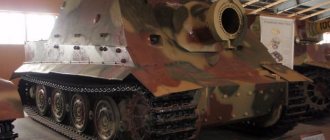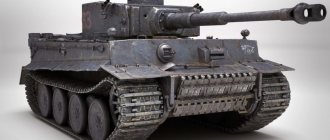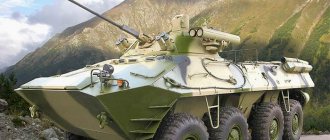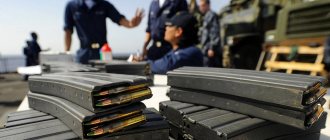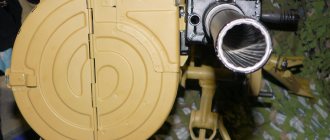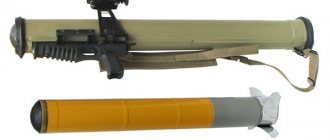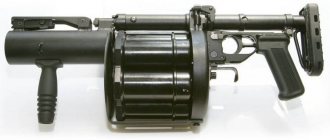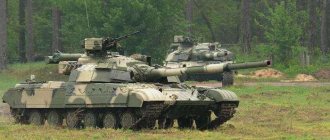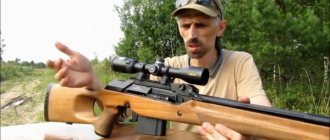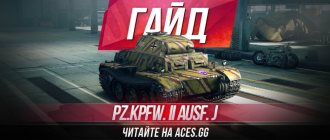“Panzerkampfwagen IV” (“PzKpfw IV”, also “Pz. IV”; in the USSR it was also known as “T-IV”) - a medium tank of the Wehrmacht armored forces during the Second World War. There is a version that the Pz IV was originally classified by the Germans as a heavy tank, but it is not documented.
The most popular tank of the Wehrmacht: 8,686 vehicles were produced; It was mass-produced from 1937 to 1945 in several modifications. The constantly increasing armament and armor of the tank in most cases allowed the PzKpfw IV to effectively resist tanks of a similar class. French tanker Pierre Danois wrote about the PzKpfw IV (in modification, at that time, with a short-barreled 75-mm cannon): “This medium tank was superior to our B1 and B1 bis in all respects, including armament and, to some extent, armor "
History of creation
Under the terms of the Treaty of Versailles, Germany, defeated in World War I, was prohibited from having armored forces, with the exception of a small number of armored vehicles for police use. But despite this, already since 1925, the Reichswehr Armament Directorate had been secretly working on the creation of tanks. Until the early 1930s, these developments did not go beyond the construction of prototypes, both because of the insufficient characteristics of the latter and because of the weakness of German industry of that period. However, by mid-1933, German designers managed to create their first production tank, the Pz.Kpfw.I, and began mass production during 1933-1934. The Pz.Kpfw.I, with its machine gun armament and two-man crew, was considered only as a transitional model on the way to the construction of more advanced tanks. The development of two of them began back in 1933 - a more powerful “transitional” tank, the future Pz.Kpfw.II, and a full-fledged battle tank, the future Pz.Kpfw.III, armed with a 37-mm cannon, intended mainly to fight other armored vehicles.
Due to the initial limitations of the PzIII's armament, it was decided to complement it with a fire support tank, with a longer-range cannon with a powerful fragmentation shell capable of hitting anti-tank defenses beyond the range of other tanks. In January 1934, the Armament Directorate organized a competition of projects to create a vehicle of this class, whose mass would not exceed 24 tons. Since work on armored vehicles in Germany at that time was still carried out in secret, the new project, like the others, was given the code name “support vehicle” (German: Begleitwagen, usually shortened to BW; a number of sources give incorrect names in German: Bataillonwagen and German: Bataillonfuehrerwagen). From the very beginning, Krupp also began developing projects for the competition, later they were joined by Daimler-Benz and MAN. Over the next 18 months, all presented their developments under the designation VK 2001 (Rh) was even made in metal in 1934-1935 in the form of a prototype.
Tank Pz.Kpfw. IV Ausf. J (Armored Vehicle Museum - Latrun, Israel)
All presented projects had a chassis with a staggered arrangement of large-diameter road wheels and the absence of support rollers, with the exception of the same VK 2001(Rh), which generally inherited the chassis with small-diameter road wheels interlocked in pairs and side screens from the experimental Nb heavy tank. Fz. The best of them was eventually recognized as the Krupp project - VK 2001 (K), but the Armament Directorate was not satisfied with its leaf spring suspension, which they demanded to replace with a more advanced torsion bar. However, Krupp insisted on using a chassis with medium-diameter rollers interlocked in pairs on a spring suspension, borrowed from the rejected Pz.Kpfw.III prototype of its own design. In order to avoid the inevitable delays in reworking the project for torsion bar suspension in the start of production of the tank, which was urgently needed by the army, the Armament Directorate was forced to agree to Krupp’s proposal. After further refinement of the project, Krupp received an order for the production of a pre-production batch of a new tank, which by that time had received the designation “armored vehicle with a 75-mm gun” (German: 7.5 cm Geschütz-Panzerwagen) or, according to the end-to-end designation system adopted at that time, "experimental sample 618" (German: Versuchskraftfahrzeug 618 or Vs.Kfz.618). Since April 1936, the tank acquired its final designation - Panzerkampfwagen IV or Pz.Kpfw.IV. In addition, it was assigned the index Vs.Kfz.222, which previously belonged to the Pz.Kpfw.II.
Tank PzKpfw IV Ausf G. Armored Museum in Kubinka.
Wehrmacht workhorse
Despite the fact that there were fighting vehicles more modern than the German T-4 tank - "Tiger", "Panther" and "Royal Tiger", it not only constituted the majority of the Wehrmacht's weapons, but was also part of many elite SS divisions. The recipe for success was probably the large hull and turret, ease of maintenance, reliability and robust chassis, which allowed for an expanded array of weapons compared to the Panzer III. From the Model A to the F1, early versions using a short 75 mm barrel were gradually replaced by the "long" ones, F2 to H, with a very effective high-velocity gun inherited from the Pak 40, which could cope with the Soviet KV-1 and T -34. In the end, the German T-4 tank (photo presented in the article) completely surpassed the Panzer III both in numbers and in its capabilities.
Krupp prototype design
It was originally intended that the German T-4 tank, the technical characteristics of which were determined in 1934 by the Waffenamt, would serve as an “escort vehicle” in order to hide its true role, prohibited by the terms of the Treaty of Versailles.
Heinz Guderian took part in the development of the concept. This new model was to become an infantry support tank and be placed in the rearguard of tank divisions. It was planned that at the battalion level there should be one such vehicle for every three Panzer IIIs. Unlike the T-3, which was equipped with a variant of the standard 37 mm Pak 36 gun with good anti-tank performance, the short barrel of the Panzer IV howitzer could be used against all types of fortifications, blockhouses, pillboxes, anti-tank guns and artillery positions.
Initially, the weight limit for a combat vehicle was 24 tons. MAN, Krupp and Rheinmetall-Borsig created three prototypes, and Krupp received the main contract. The suspension was initially completely new, with six alternating wheels. Later the Army required the installation of rod springs, which provided better vertical deflection. Compared to the previous system, this made the ride smoother, but the need for a new tank stopped further development. Krupp returned to a more traditional system with four twin-wheel bogies and leaf springs for easier servicing. A crew of five was planned - three were in the turret (commander, loader and gunner), and the driver and radio operator were in the hull. The fighting compartment was relatively spacious, with improved sound insulation in the rear engine compartment. The inside of the German T-4 tank (photos in the material illustrate this) was equipped with an onboard communication system and radio.
Although it's not very noticeable, the Panzer IV's hull is asymmetrical, with the turret offset 6.5 cm to the left and the engine 15 cm to the right. This was done in order to directly connect the turret ring to the transmission for faster rotation. As a result, the ammunition boxes were located on the right.
The prototype, developed and built in 1936 at the Krupp AG plant in Magdeburg, was designated Versuchskraftfahrzeug 622 by the Army Weapons Office. However, in the new pre-war nomenclature it quickly became known as the Pz.Kpfw.IV (Sd.Kfz. 161).
The tank had a Maybach HL108TR gasoline engine with a power of 250 hp. s., and a SGR 75 gearbox with five forward and one reverse gears. The maximum speed tested on a flat surface was 31 km/h.
75 mm gun – low-velocity Kampfwagenkanone (KwK) 37 L/24. This weapon was intended to fire high-explosive shells at concrete fortifications. However, some anti-tank capability was provided by the Panzergranate armor-piercing projectile, whose speed reached 440 m/s. It could penetrate a 43 mm sheet of steel at a distance of 700 m. Two MG-34 machine guns completed the armament, one coaxial and the other at the front of the vehicle.
In the first batch of Type A tanks, the thickness of the hull armor did not exceed 15 mm and the turret armor did not exceed 20 mm. Although it was hardened steel, such protection could only withstand light firearms, light artillery and grenade launcher fragments.
Mass production
Panzerkampfwagen IV Ausf.A - Ausf.F1
The first few Pz.Kpfw.IV "zero" series were manufactured in 1936-1937 in Essen. Serial production of the first series, 1.Serie/BW, began in October 1937 in Magdeburg. A total of 35 tanks of this modification, designated Panzerkampfwagen IV Ausführung A (Ausf.A - “model A”), were produced until March 1938. According to the unified designation system for German armored vehicles, the tank received the index Sd.Kfz.161. Ausf.A tanks were in many ways still pre-production vehicles and carried bulletproof armor that did not exceed 15-20 mm and poorly protected surveillance devices, especially in the commander's cupola. At the same time, the main design features of the Pz.Kpfw.IV had already been determined at Ausf.A, and although the tank was subsequently subjected to modernization many times, the changes mainly came down to the installation of more powerful armor and weapons, or to unprincipled alterations of individual components.
Immediately after the end of production of the first series, Krupp began production of an improved one - 2.Serie/BW or Ausf.B. The most noticeable external difference between the tanks of this modification was the straight upper frontal plate, without a prominent “cabinet” for the driver and with the elimination of the course machine gun, which was replaced by a viewing device and a hatch for firing from personal weapons. The design of the viewing devices was also improved, primarily the commander's cupola, which received armored flaps, and the driver's viewing device. According to other sources, the new commander's cupola was introduced already during the production process, so that some Ausf.B tanks carried the old type commander's cupola. Minor changes affected the landing hatches and various hatches. The frontal armor on the new modification was increased to 30 mm. The tank also received a more powerful engine and a new 6-speed gearbox, which significantly increased its maximum speed, and its range also increased. At the same time, the Ausf.B's ammunition load was reduced to 80 gun rounds and 2,700 machine-gun rounds, instead of 120 and 3,000, respectively, on the Ausf.A. Krupp was given an order for the production of 45 Ausf.B tanks, but due to a shortage of components, only 42 vehicles of this modification were actually produced from April to September 1938.
Tank Pz.Kpfw.IV Ausf.A on parade, 1938.
The first relatively widespread modification was the 3.Serie/BW or Ausf.C. Compared to the Ausf.B, the changes in it were minor - externally, both modifications are distinguishable only by the presence of an armored casing for the barrel of the coaxial machine gun. The remaining changes consisted of replacing the HL 120TR engine with an HL 120TRM of the same power, as well as installing a bumper under the gun barrel on some of the tanks to bend the antenna located on the hull when the turret is rotated. A total of 300 tanks of this modification were ordered, but already in March 1938 the order was reduced to 140 units, as a result of which from September 1938 to August 1939, according to various sources, 140 or 134 tanks were produced, while 6 chassis were transferred for conversion into bridge laying machines.
Museum Pz.Kpfw.IV Ausf.D with additional armor
The next modification, Ausf.D, was produced in two series - 4.Serie/BW and 5.Serie/BW. The most noticeable external change was the return to the broken upper frontal plate of the hull and the forward machine gun, which received enhanced protection. The internal mantlet of the gun, which proved vulnerable to lead splashes from bullet hits, was replaced with an external one. The thickness of the side and rear armor of the hull and turret was increased to 20 mm. In January 1938, Krupp received an order for the production of 200 4.Serie/BW and 48 5.Serie/BW vehicles, but during production, from October 1939 to May 1941, only 229 of them were completed as tanks, while the remaining 19 were allocated for the construction of specialized variants. Some of the later Ausf.D tanks were produced in a “tropical” version (German tropen or Tp.), with additional ventilation holes in the engine compartment. A number of sources speak of reinforcement of armor carried out in units or during repairs in 1940-1941, which was carried out by bolting additional 20-mm sheets onto the upper side and front plates of the tank. According to other sources, later production vehicles were standardly equipped with additional 20 mm side and 30 mm frontal armor plates of the Ausf.E type. Several Ausf.Ds were re-equipped with long-barreled KwK 40 L/48 guns in 1943, but these converted tanks were used only as training tanks.
Tank Pz.Kpfw.IV Ausf.B or Ausf.C during exercises. November 1943.
The appearance of a new modification, 6.Serie/BW or Ausf.E, was caused primarily by the insufficient armor protection of early series vehicles, demonstrated during the Polish campaign. On the Ausf.E, the thickness of the lower frontal plate was increased to 50 mm; in addition, the installation of additional 30 mm plates above the upper front and 20 mm above the side plates became standard, although on a small part of early production tanks additional 30 mm plates were not were installed. The armor protection of the turret, however, remained the same - 30 mm for the front plate, 20 mm for the side and rear plates and 35 mm for the gun mantlet. A new commander's cupola was introduced, with vertical armor thickness from 50 to 95 mm. The slope of the rear wall of the turret was also reduced, which was now made of a single sheet, without a “swell” for the turret, and on late-production vehicles an unarmored box for equipment began to be attached to the rear of the turret. In addition, the Ausf.E tanks were distinguished by a number of less noticeable changes - a new driver's viewing device, simplified drive and guide wheels, an improved design of various hatches and inspection hatches, and the introduction of a turret fan. The order for the sixth series of Pz.Kpfw.IV amounted to 225 units and was completed in full between September 1940 and April 1941, in parallel with the production of Ausf.D tanks.
Pz.Kpfw.IV Ausf.F. Finland, 1941.
Shielding with additional armor (on average 10-12 mm), used on previous modifications, was irrational and was considered only as a temporary solution, which was the reason for the appearance of the next modification, 7.Serie/BW or Ausf.F. Instead of using mounted armor, the thickness of the frontal upper plate of the hull, the frontal plate of the turret and the gun mantlet was increased to 50 mm, and the thickness of the sides of the hull and the sides and rear of the turret was increased to 30 mm. The broken upper front plate of the hull was again replaced with a straight one, but this time with the preservation of the forward-facing machine gun, and the side hatches of the turret received double doors. Due to the fact that the mass of the tank after the changes increased by 22.5% compared to the Ausf.A, wider tracks were introduced to reduce the specific ground pressure. Other, less noticeable changes included the introduction of ventilation air intakes in the middle frontal plate to cool the brakes, a different location of mufflers and slightly modified viewing devices due to the thickening of the armor and the installation of a directional machine gun. With the Ausf.F modification, others joined the production of the Pz.Kpfw.IV for the first time. The latter received the first order for 500 vehicles of the seventh series, later orders for 100 and 25 units were also received by Nibelungenwerke. Of this quantity, from April 1941 to March 1942, before production switched to the Ausf.F2 modification, 462 Ausf.F tanks were produced, 25 of which were converted to Ausf.F2 at the factory.
Tank Pz.Kpfw.IV Ausf.E. Yugoslavia, 1941.
Panzerkampfwagen IV Ausf.F2 - Ausf.J
Although the main purpose of the 75-mm Pz.Kpfw.IV cannon was to destroy unarmored or lightly armored targets, the presence of an armor-piercing projectile in its ammunition allowed the tank to successfully fight armored vehicles protected by bulletproof or light anti-ballistic armor. But against tanks with powerful anti-ballistic armor, such as the British Matilda or the Soviet KV and T-34, it turned out to be completely ineffective. Back in 1940 - early 1941, the successful combat use of the Matilda intensified work on re-equipping the PzIV with a weapon with better anti-tank capabilities. On February 19, 1941, by personal order of A. Hitler, work began on arming the tank with a 50-mm Kw.K.38 L/42 cannon, which was also installed on the Pz.Kpfw.III, and subsequently work began on strengthening the Pz.Kpfw's armament. IV also advanced under his control. In April, one Pz.Kpfw.IV Ausf.D was re-equipped with the newer, more powerful, 50 mm Kw.K.39 L/60 cannon for demonstration to Hitler for his birthday, April 20. It was even planned to produce a series of 80 tanks with such weapons from August 1941, but by that time the interest of the Armament Directorate (Heereswaffenamt) had shifted to the 75 mm long-barreled gun and these plans were abandoned.
Since the Kw.K.39 had already been approved as armament for the Pz.Kpfw.III, it was decided to choose an even more powerful gun for the Pz.Kpfw.IV, which could not be installed on the Pz.Kpfw.III with its smaller turret ring diameter . Since March 1941, Krupp, as an alternative to the 50-mm cannon, has been considering a new 75-mm cannon with a barrel length of 40 calibers, intended for re-equipping the StuG.III assault guns. At a distance of 400 meters, it penetrated 70 mm armor at an angle of 60°, but since the Armament Directorate required that the gun barrel not protrude beyond the dimensions of the tank hull, its length was reduced to 33 calibers, which resulted in a decrease in armor penetration to 59 mm under the same conditions. It was also planned to develop a sub-caliber armor-piercing projectile with a separating pan, which would penetrate 86 mm armor under the same conditions. Work to re-equip the Pz.Kpfw.IV with a new gun progressed successfully, and in December 1941 the first prototype with a 7.5 cm Kw.K gun was built. L/34.5.
Tank Pz.Kpfw.IV Ausf.F2. France, July 1942.
Meanwhile, the invasion of the USSR began, during which German troops encountered T-34 and KV tanks, which were low-vulnerable to the main tank and anti-tank guns of the Wehrmacht and at the same time carried a 76-mm cannon that pierced the frontal armor of German tanks, which were then practically in service with the Panzerwaffe. at any real combat distances. The Special Tank Commission, sent to the front in November 1941 to study this issue, recommended the rearmament of German tanks with a weapon that would allow them to hit Soviet vehicles from long distances, while remaining outside the radius of the latter's effective fire. On November 18, 1941, the development of a tank gun was initiated, similar in its capabilities to the new 75-mm anti-tank gun Pak 40. Such a gun, initially designated Kw.K.44, was developed jointly by Rheinmetall. The barrel passed to it from the anti-tank gun without changes, but since the latter's shots were too long for use in a tank, a shorter and thicker sleeve was developed for the tank gun, which entailed reworking the breech of the gun and reducing the overall length of the barrel to 43 calibers. The Kw.K.44 also received a single-chamber spherical muzzle brake, which differed from the anti-tank gun. In this form, the gun was adopted as the 7.5 cm Kw.K.40 L/43.
Pz.Kpfw.IVs with the new gun were initially designated as "converted" (German: 7.Serie/BW-Umbau or Ausf.F-Umbau), but soon received the designation Ausf.F2, while the Ausf.F vehicles with the old ones the guns began to be called Ausf.F1 to avoid confusion[28]. The designation of the tank according to the unified system changed to Sd.Kfz.161/1. With the exception of a different gun and associated minor changes, such as the installation of a new sight, new firing positions and slightly modified armor for the gun's recoil devices, the early Ausf.F2s were identical to the Ausf.F1 tanks. After a month's break associated with the transition to a new modification, production of the Ausf.F2 began in March 1942 and continued until July of the same year. A total of 175 tanks of this variant were produced and another 25 were converted from Ausf.F1.
Tank Pz.Kpfw. IV Ausf. G (tail number 727) of the 1st Panzergrenadier Division "Leibstandarte SS Adolf Hitler". The vehicle was hit by artillerymen of the 4th battery of the 595th anti-tank artillery regiment in the area of the street. Sumskaya in Kharkov, on the night of March 11-12, 1943. On the frontal armor plate, almost in the center, two entrance holes from 76-mm shells are visible.
The appearance of the next modification of the Pz.Kpfw.IV was not initially caused by any changes in the design of the tank. In June - July 1942, by orders of the Armament Directorate, the designation Pz.Kpfw.IV with long-barreled guns was changed to 8.Serie/BW or Ausf.G, and in October the designation Ausf.F2 was finally abolished for previously produced tanks of this modification. The first tanks, released as Ausf.G, were thus identical to their predecessors, but as production continued, more and more changes were made to the tank's design. Ausf.G of early releases still carried the index Sd.Kfz.161/1 according to the end-to-end designation system, which was replaced by Sd.Kfz.161/2 on vehicles of later releases. The first changes made already in the summer of 1942 included a new two-chamber pear-shaped muzzle brake, the elimination of viewing devices in the front side plates of the turret and the loader's inspection hatch in its frontal plate, the transfer of smoke grenade launchers from the rear of the hull to the sides of the turret, and a system for facilitating launch in winter conditions. .
Since the 50 mm frontal armor of the Pz.Kpfw.IV was still insufficient, not providing adequate protection against 57 mm and 76 mm guns, it was again reinforced by welding or, on later production vehicles, bolting additional 30-mm mm of plates above the upper and lower frontal plates of the hull. The thickness of the front plate of the turret and gun mantlet, however, was still 50 mm and did not increase during further modernization of the tank. The introduction of additional armor began with the Ausf.F2, when 8 tanks with increased armor thickness were produced in May 1942, but progress was slow. By November, only about half of the vehicles were produced with reinforced armor, and only from January 1943 did it become standard for all new tanks. Another significant change introduced to the Ausf.G from the spring of 1943 was the replacement of the Kw.K.40 L/43 gun with the Kw.K.40 L/48 with a 48-caliber barrel length, which had slightly higher armor penetration. Production of the Ausf.G continued until June 1943; a total of 1,687 tanks of this modification were produced. Of this number, about 700 tanks received reinforced armor and 412 received the Kw.K.40 L/48 gun.
Pz.Kpfw.IV Ausf.H with side screens and zimmerit coating. USSR, July 1944.
The next modification, Ausf.H, became the most widespread. The first tanks under this designation, which rolled off the assembly line in April 1943, differed from the last Ausf.G only in the thickening of the front turret roof sheet to 16 mm and the rear one to 25 mm, as well as reinforced final drives with cast drive wheels, but the first 30 tanks Ausf.H, due to delays in the supply of new components, only received a thicker roof. Since the summer of the same year, instead of additional 30 mm hull armor, solid-rolled 80 mm plates were introduced to simplify production. In addition, hinged anti-cumulative screens made of 5 mm sheets were introduced, installed on most Ausf.H. In this regard, viewing devices on the sides of the hull and turret were eliminated as unnecessary. Since September, tanks have been coated with vertical armor with Zimmerit to protect them from magnetic mines.
Ausf.H tanks of later production received a turret mount for the MG-42 machine gun at the commander's cupola hatch, as well as a vertical rear plate instead of the inclined one that was present on all previous modifications of the tanks. During production, various changes were also introduced to make production cheaper and easier, such as the introduction of non-rubber support rollers and the elimination of the driver's periscopic viewing device. From December 1943, the frontal hull plates began to be connected to the side joints in a “tenon” manner to enhance resistance to shell hits. Production of the Ausf.H continued until July 1944. Data on the number of tanks of this modification produced, given in various sources, vary somewhat, from 3935 chassis, of which 3774 were completed as tanks, to 3960 chassis and 3839 tanks.
The German medium tank Pz.Kpfw destroyed on the Eastern Front. IV lying upside down on the side of the road. Part of the caterpillar in contact with the ground is missing, in the same place there are no rollers with a fragment of the lower part of the hull, a bottom sheet is torn off, and the second caterpillar is torn off. The upper part of the car, as far as one can judge, does not suffer such fatal damage. A typical picture of a landmine explosion.
The appearance of the Ausf.J modification on assembly lines in June 1944 was associated with the desire to reduce the cost and simplify the production of the tank as much as possible in the conditions of Germany's deteriorating strategic position. The only, but significant, change that distinguished the first Ausf.J from the last Ausf.H was the elimination of the electric drive for turning the turret and the associated auxiliary carburetor engine with a generator. Soon after the start of production of the new modification, the pistol ports in the stern and sides of the turret, which were useless due to the screens, were eliminated, and the design of other hatches was simplified. Since July, an additional fuel tank with a capacity of 200 liters began to be installed in place of the liquidated auxiliary engine, but the fight against its leakage dragged on until September 1944. In addition, the 12-mm hull roof began to be reinforced by welding additional 16-mm sheets. All subsequent changes were aimed at further simplifying the design, the most notable among them being the abandonment of the Zimmerit coating in September and the reduction in the number of support rollers to three per side in December 1944. Production of tanks of the Ausf.J modification continued almost until the very end of the war, until March 1945, but a decrease in production rates associated with the weakening of German industry and difficulties with the supply of raw materials led to the fact that only 1,758 tanks of this modification were produced.
Production volumes of the T-4 tank
Design
The Pz.Kpfw.IV had a layout with a combined transmission and control compartment located in the front, an engine compartment in the rear, and a fighting compartment in the middle part of the vehicle. The tank's crew consisted of five people: a driver and gunner-radio operator, located in the control compartment, and a gunner, loader and tank commander, located in a three-man turret.
Armored hull and turret
The turret of the PzKpfw IV tank made it possible to modernize the tank's gun. Inside the turret there was a commander, gunner and loader. The commander's position was located directly under the commander's cupola, the gunner was located to the left of the breech of the gun, and the loader was located to the right. Additional protection was provided by anti-cumulative screens, which were also installed on the sides. The commander's cupola at the rear of the turret gave the tank good visibility. The tower had an electric drive for rotation.
Soviet soldiers examine a broken German Pz.Kpfw tank. IV Ausf. H (single-leaf hatch and absence of three-barrel grenade launchers on the turret). The tank is painted in three-color camouflage. Oryol-Kursk direction.
Surveillance and communications equipment
In non-combat conditions, the tank commander, as a rule, conducted observation while standing in the hatch of the commander's cupola. In battle, to view the area, he had five wide viewing slits around the perimeter of the commander's cupola, giving him an all-round view. The commander's viewing slits, like those of all other crew members, were equipped with a protective triplex glass block on the inside. On the Pz.Kpfw.IV Ausf.A the viewing slots did not have any additional cover, but on the Ausf.B the slots were equipped with sliding armor flaps; in this form, the commander’s viewing devices remained unchanged on all subsequent modifications. In addition, on tanks of early modifications, the commander's cupola had a mechanical device for determining the target's heading angle, with the help of which the commander could carry out precise target designation to the gunner, who had a similar device. However, due to excessive complexity, this system was eliminated, starting with the Ausf.F2 modification. The gunner's and loader's viewing devices on Ausf.A - Ausf.F consisted of, for each of them: a viewing hatch with an armored cover without viewing slots, in the front plate of the turret on the sides of the gun mantlet; an inspection hatch with a slot in the front side sheets and an inspection slot in the turret side hatch cover. Starting with the Ausf.G, as well as on some of the Ausf.F2 of late production, the inspection devices in the front side plates and the loader's inspection hatch in the front plate were eliminated. On some tanks of the Ausf.H and Ausf.J modifications, due to the installation of anti-cumulative screens, the viewing devices on the sides of the turret were completely eliminated.
The main means of observation for the driver of the Pz.Kpfw.IV was a wide viewing slot in the front hull plate. On the inside, the gap was protected by a triplex glass block; on the outside, on the Ausf.A it could be closed with a simple folding armor flap; on the Ausf.B and subsequent modifications, it could be closed with a Sehklappe 30 or 50 sliding flap, which was also used on the Pz.Kpfw.III. A KFF1 periscope binocular viewing device was located above the viewing slit on Ausf.A, but it was eliminated on Ausf.B - Ausf.D. On Ausf.E - Ausf.G the viewing device appeared in the form of an improved KFF2, but starting with Ausf.H it was abandoned again. The device was brought out into two holes in the front plate of the body and, if there was no need for it, was moved to the right. The radio operator-gunner on most modifications did not have any means of viewing the frontal sector, in addition to the sight of the forward machine gun, but on Ausf.B, Ausf.C and parts of Ausf.D, in place of the machine gun there was a hatch with a viewing slot in it. Similar hatches were located in the side plates on most Pz.Kpfw.IVs, being eliminated only on Ausf.Js due to the installation of anti-cumulative shields. In addition, the driver had a turret position indicator, one of two lights warned about the turret turning to one side or another in order to avoid damage to the gun when driving in cramped conditions.
For external communications, Pz.Kpfw.IV platoon commanders and above were equipped with a Fu 5 model VHF radio station and a Fu 2 receiver. Line tanks were equipped only with a Fu 2 receiver. FuG5 had a transmitter power of 10 W and provided a communication range of 9.4 km in telegraph and 6.4 km in telephone mode. For internal communications, all Pz.Kpfw.IVs were equipped with a tank intercom for four crew members, with the exception of the loader.
German tank Pz.Kpfw. IV Ausf. H of the training tank division (Panzer-Lehr-Division), knocked out in Normandy. In front of the tank is a unitary high-explosive fragmentation round Sprgr.34 (weight 8.71 kg, explosive - ammotol) for the 75-mm KwK.40 L/48 cannon. The second shell lies on the body of the vehicle, in front of the turret.
Engine and transmission
The Pz.Kpfw.IV was equipped with a V-shaped 12-cylinder four-stroke liquid-cooled carburetor engine, models HL 108TR, HL 120TR and HL 120TRM. Ausf.A modification tanks were equipped with the HL 108TR engine, which had a displacement of 10,838 cm³ and developed a maximum power of 250 hp. With. at 3000 rpm. The Pz.Kpfw.IV Ausf.B used an HL 120TR engine with a displacement of 11,867 cm³, developing a power of 300 hp. With. at 3000 rpm, and on tanks of the Ausf.C modification and all subsequent ones - its version HL 120TRM, which differed only in small details. At 2600 rpm, recommended by the operating instructions as maximum under normal conditions, the HL 120TR engine power was 265 hp. With.
The engine was placed longitudinally in the engine compartment, offset to the starboard side. The engine cooling system included two parallel-connected radiators located in the left half of the engine compartment and two fans located on the right side of the engine. The radiators were located at an angle relative to the engine compartment lid for better air circulation. Air circulation in the engine compartment was carried out through two armored air intakes on both sides of the compartment. Fuel tanks, on most modifications - three, with a capacity of 140, 110 and 170 liters, were also located in the engine compartment. The Pz.Kpfw.IV Ausf.J was equipped with a fourth tank with a capacity of 189 liters. The engine was fueled by leaded gasoline with an octane rating of at least 74.
The Pz.Kpfw.IV transmission included:
– a driveshaft that connected the engine to the rest of the transmission units; – three-disc main dry friction clutch; – mechanical three-shaft gearbox with spring disc synchronizers - five-speed (5+1) SFG75 on Ausf.A, six-speed (6+1) SSG76 on Ausf.B - Ausf.G and SSG77 on Ausf.H and Ausf.J; – planetary rotation mechanism; – two final drives; – onboard brakes.
The final drives and brakes were cooled using a fan installed to the left of the main clutch.
The medium tank Pz.Kpfw.IV Ausf, knocked out in the battles near Breslau and completely burned out. H late release. The tank was disabled by a single hit from a 76 mm armor-piercing shell to the forehead of the turret. The front of the hull is almost completely covered by track tracks for increased protection.
Chassis
The chassis of the Pz.Kpfw.IV, applied to one side, consisted of eight dual rubber-coated road wheels with a diameter of 470 mm, four, or (on the part of the Ausf.J) three double support rollers - rubber-coated on most vehicles, with the exception of the Ausf.J and part of the Ausf .H, drive wheel and idler. The track rollers were interlocked in pairs on balancers with suspension on quarter-elliptic leaf springs.
The tracks of the Pz.Kpfw.IV are steel, small-linked, pinion geared, single-ridged. On early modifications, the track had a width of 360 mm with a pitch of 120 mm and consisted of 101 Kgs 61/360/120 tracks. Starting with the Ausf.F modification, due to the increased weight of the tank, a 400 mm wide Kgs 61/400/120 track was used, and the number of tracks was reduced to 99. Later, tracks with additional lugs were introduced for better traction on icy surfaces in winter conditions . In addition, on the Soviet-German front, expanders of various types were sometimes installed on the tracks.
Vehicles based on Panzerkampfwagen IV
Serial
– Sturmgeschütz IV (StuG IV) is a medium-weight self-propelled artillery unit of the assault gun class. – Nashorn (Hornisse) is a medium-weight anti-tank self-propelled artillery unit. – Möbelwagen 3.7 cm FlaK auf Fgst Pz.Kpfw. IV(sf); Flakpanzer IV "Möbelwagen" is a self-propelled anti-aircraft gun. – Jagdpanzer IV is a medium-weight self-propelled artillery unit of the tank destroyer class. – Munitionsschlepper - ammunition transporter for self-propelled mortars of the Gerat 040/041 (“Karl”) type. – Sturmpanzer IV (Brummbär) is a medium-weight self-propelled artillery unit of the assault gun / self-propelled howitzer class. – Hummel is a self-propelled howitzer. – Flakpanzer IV (2cm Vierling) Wirbelwind – self-propelled anti-aircraft gun. – Flakpanzer IV (3.7cm FlaK) Ostwind – self-propelled anti-aircraft gun.
Experienced
– PzKpfw IV Hydrostatic - modification with hydrostatic drive.
Destroyed German medium tank Pz.Kpfw. IV on the Kursk Bulge. In the background is a retreating Soviet light tank T-70 with soldiers.
Combat use
early years
The first three Pz.Kpfw.IV Ausf.As entered service by January 1938, and by April the number of tanks of this type in the army increased to 30. Already in April of the same year, Pz.Kpfw.IVs were used during the Anschluss of Austria, and in October - during the occupation of the Sudetenland of Czechoslovakia. But although their number in active units, as well as the rate of production, was constantly increasing, before the start of World War II, Pz.Kpfw.IVs accounted for less than 10% of the Wehrmacht’s tank fleet. The number of Pz.Kpfw.IV tanks (75 mm Kwk 37 short-barreled gun, two 7.92 mm machine guns) in the army as of June 1, 1941 was 439.
The Second World War
Export
Tank Pz.Kpfw. IV was exported to various countries. In 1942-1944. Germany exported 490 vehicles.
Post-war use
The tank was also used in many battles after World War II: it was actively used by the Israel Defense Forces, the Syrian Armed Forces and the armies of other Middle Eastern countries during the wars of 1950-1970, namely: the Israeli War of Independence 1948-1949 , the Suez conflict of 1956, the Six Day War of 1967 and other conflicts. Also used by the armies of Iraq and Iran in the Iran-Iraq War of 1980-1988.
For a long time it was in service with the armies of Europe - Hungary, Bulgaria, Finland, France, Croatia and Spain, etc.
Red Army soldiers capture a German Pz.Kpfw tank that was knocked out on the battlefield near Mozdok. IV Ausf F-2. The tank does not have a front-mounted machine gun.
Early "short" preliminary episodes
The German T-4 A tank was a kind of preliminary series of 35 units produced in 1936. The next one was the Ausf. B with a modified commander's canopy, a new Maybach HL 120TR engine developing 300 hp. pp., as well as a new transmission SSG75.
Despite the extra weight, top speed has increased to 39 km/h and protection has been enhanced. The thickness of the armor reached 30 mm in the front inclined part of the hull and 15 mm in other places. In addition, the machine gun was protected by a new hatch.
After the production of 42 vehicles, production switched to the German T-4 C tank. The thickness of the armor on the turret increased to 30 mm. The total weight was 18.15 tons. After delivery of 40 units in 1938, the tank was improved by installing a new Maybach HL 120TRM engine for the next hundred vehicles. It is quite logical that modification D followed. The Dora can be distinguished by the machine gun newly installed on the hull and the embrasure placed outside. The thickness of the side armor increased to 20 mm. A total of 243 vehicles of this model were manufactured, the last of which was at the beginning of 1940. Modification D was the last pre-production one, after which the command decided to increase the scale of production.
Upgrades of the Panzerkampfwagen IV tank
With experience in clashes with combat vehicles of the USSR and its allies, the German tank was constantly improved. Initially, it had light armor and a short-barreled 75 mm gun with a 24-caliber barrel that fired high-explosive fragmentation shells. However, the launch speed of such a projectile, which was considered low and amounted to only 385 m/s, could not cause significant damage to enemy tanks.
Over time, the tank gradually began to acquire armor, and its combat power was increased by installing a long-barreled 48-caliber gun. The latest modification of the Panzerkampfwagen IV tank could already provide decent resistance to USSR tanks. However, it also had a number of significant disadvantages.
Standardization
The German T-4 E tank was the first large-scale series to be produced during the war. Although many studies and reports point to the lack of penetration of the Panzer III's 37mm gun, replacing it was not possible. Looking for a solution to conduct testing on one prototype Panzer IV Ausf. D, a modification of the Pak 38 medium-velocity 50 mm cannon was installed. The initial order for 80 units was canceled after the end of the French campaign. In tank battles, in particular against the British Matilda and the French B1 bis, it finally became clear that the thickness of the armor was insufficient and the penetrating power of the gun was weak. In Ausf. E retained the short-barreled KwK 37L/24 gun, but the thickness of the front armor was increased to 50 mm, with 30 mm steel plate overlays as a temporary measure. By April 1941, when this modification was replaced by Ausf. F, its production reached 280 units.
Photo of the T-4 tank
Two British soldiers inspect an exploded German Pz.Kpfw.IV tank in the North African desert. Tak was blown up by British bombers due to the impossibility of evacuating it.
Soviet soldiers move past a smoking German Pz.Kpfw tank. IV. in the village of Krasnoarmeysk (now Volgograd region), near the Stalingrad shipyard (plant No. 264). The building in the photo is a fire station near the entrance of the plant.
Artillerymen of the Soviet 6th Tank Brigade inspect damaged German Pz.Kpfw tanks. IV (in the foreground) and Pz.Kpfw. III. Southwestern Front.
Source
The last "short" model
Another modification significantly changed the German T-4 tank. The characteristics of the early F model, renamed F1 when the next one was introduced, changed due to the replacement of the front cover plate with a 50 mm plate and an increase in the thickness of the side parts of the hull and turret to 30 mm. The total weight of the tank increased to over 22 tons, which forced other changes such as increasing the width of the tracks from 380 to 400 mm to reduce ground pressure, with a corresponding change in the two idler and drive wheels. The F1 was produced in 464 units before its replacement in March 1942.
Tactical and technical characteristics of the T-4 tank
Crew, people: 5 Developer: Krupp Manufacturer: Friedrich Krupp AG Hoesch-Krupp Years of production: 1936—1945 Years of operation: 1939—1970 Number of production, pcs.: 8686
T-4 tank weight
– 24 tons
Dimensions of the T-4 tank
– Case length, mm: 5890 – Case width, mm: 2880 – Height, mm: 2680
T-4 tank armor
– Armor type: forged and rolled steel with surface hardening – Hull front, mm/deg.: 80 – Hull side, mm/deg.: 30 – Hull rear, mm/deg.: 20 – Turret forehead, mm/deg.: 50 – Tower side, mm/deg.: 30 – Tower stern, mm/deg.: 30 – Tower roof, mm: 18
Armament of the T-4 tank
– Caliber and brand of gun: 75 mm KwK 37, KwK 40 L/43, KwK 40 L/48 – Barrel length, calibers: 24, 43, 48 – Gun ammunition: 87 – Machine guns: 2 × 7.92 mm MG -34
T-4 tank engine
– Engine power, l. pp.: 300
Speed of the T-4 tank
– Highway speed, km/h: 40
– Cruising range on the highway, km: 300 – Specific power, l. s./t: 13
The first "long"
Even with the armor-piercing Panzergranate round, the Panzer IV's low-velocity gun was no match for heavily armored tanks. In the context of the upcoming campaign in the USSR, a decision had to be made on a major upgrade of the T-3 tank. The now available Pak 38L/60 gun, the effectiveness of which has been confirmed, was intended for installation in the Panzer IV turret. In November 1941, the prototype was completed and production was scheduled. But during the first battles with the Soviet KV-1 and T-34, production of the 50 mm gun, also used in the Panzer III, was discontinued in favor of a new, more powerful model from Rheinmetall based on the 75 mm Pak 40L/46 gun. This led to the development of the KwK 40L/43, a relatively long caliber equipped with a muzzle brake to reduce recoil. The initial velocity of the Panzergranade 39 projectile exceeded 990 m/s. It could penetrate 77 mm armor at a distance of up to 1850 m. After the creation of the first prototype in February 1942, mass production of the F2 began. By July, 175 units had been manufactured. In June, the German T-4 F2 tank was renamed T-4 G, but for the Waffenamt both types were designated as Sd.Kfz.161/1. In some documents the model is called F2/G.
History of creation
After defeat in the First World War, the Versailles Peace Treaty prohibited Germany from having its own armored forces. The only exception was a limited number of armored vehicles allocated for the needs of the police.
However, starting in 1925, German engineers secretly worked on creating new German tanks. This is how the first modifications of Panzerkampfwagen I, II, III and IV appeared. The last model (Panzerkampfwagen IV), which was also called T-IV, was the most massive in terms of production. This Wehrmacht medium armored tank was mass-produced from 1937 to 1945, had a lot of modifications, and is considered the most popular German tank of the Second World War.
Initially, the medium German tank Panzerkampfwagen IV was created as an artillery support tank and did an excellent job of suppressing enemy firing points. But at the same time it was practically useless in tank battles. This Wehrmacht vehicle took its first battles in 1939. During the Polish campaign, the Germans lost 19 of these vehicles, and another 79 units were lost in France. But by 1941, the Germans had 517 Panzerkampfwagen IV tanks, 439 of which took part in Operation Barbarossa.
Transitional model
The German T-4 G tank was an improved version of the F2 with changes to save metal through the use of progressive frontal armor, thicker at the base. The frontal glacis was reinforced with a new 30mm plate, increasing the thickness to a total of 80mm. This was enough to successfully counter the Soviet 76 mm gun and 76.2 mm anti-tank gun. At first they decided to bring only half of production to this standard, but in January 1943 Adolf Hitler personally ordered a complete transition. However, the weight of the car increased to 23.6 tons, revealing the limitations of the chassis and transmission.
The German T-4 tank has undergone significant changes inside. Turret inspection slits have been eliminated, engine ventilation and low-temperature ignition have been improved, and additional spare tire holders and track link brackets have been installed on the glacis. They also served as temporary protection. The headlights were updated, the armored dome was strengthened and modified.
Later versions in the spring of 1943 added side armor on the hull and turret, as well as smoke grenade launchers. But most importantly, a new, more powerful KwK 40L/48 gun has appeared. After the production of 1,275 standard and 412 improved tanks, production shifted towards the Ausf.H model.
Main version
The German T-4 N tank (photo below) was equipped with a new long-barreled KwK 40L/48 gun. Further changes concerned ease of production - the side inspection slots were removed, and spare parts common to the Panzer III were used. In total, until the next modification of Ausf. J in June 1944, 3774 vehicles were assembled.
In December 1942, Krupp received an order for a tank with fully sloped armor, which due to the additional weight required the development of a new chassis, transmission and possibly engine. However, production began with an updated version of the Ausf.G. The German T-4 tank received a new ZF Zahnradfabrik SSG-76 gearbox, a new set of radio stations (FU2 and 5, and internal communication). The thickness of the frontal armor increased to 80 mm without overlay plates. The weight of the H reached 25 tons in combat gear, and the maximum speed was reduced to 38 km/h, and in real combat conditions - to 25 km/h, and much less over rough terrain. By the end of 1943, the German T-4 N tank began to be coated with Zimmerit paste, the air filters were updated, and an anti-aircraft machine for the MG 34 was installed on the turret.
Latest simplified model
The last tank, the German T-4 J, was assembled at the Nibelungwerke in St. Valentin, Austria, as Vomag and Krupp now had other missions, and was subject to simplifications aimed at greater mass production and which rarely found support among the crews. For example, the electric drive of the turret was removed, aiming was done manually, which made it possible to increase the volume of the fuel tank by 200 liters, increasing the operating range to 300 km. Other modifications included the removal of the turret's viewing window, loopholes and anti-aircraft gun in favor of mounting a smoke grenade launcher. "Zimmerit" was no longer used, as were the Schürzen anti-cumulative "skirts", replaced by cheaper mesh panels. The engine radiator housing has also been simplified. The drive has lost one return roller. Two mufflers with flame arresters appeared, as well as a mount for a 2-ton crane. In addition, the SSG 77 transmission from the Panzer III was used, although it was clearly overloaded. Despite these sacrifices, due to constant Allied bombing, deliveries were in jeopardy, and in total only 2,970 tanks were built out of a planned 5,000 by the end of March 1945.
Modifications
- The Jagdpanzer IV is probably the best and most fearsome tank of the T-4 series, a low and very effective hunter that was particularly at home in Italy and Normandy. Since 1943, 1,980 units have been built.
- Sturmgeschütz IV is an assault tank with the already proven superstructure and armament of the Sturmgeschütz III. 1140 vehicles were created.
- Panzerbefehlswagen IV is a command post equipped with a set of radios, a full set of electronics and wiring. Used to coordinate artillery support, infantry support, and air support for tank divisions. Spacious and reliable, this is probably the best German military command tank.
- The Panzerbeobachtungswagen IV is a well-equipped artillery observation vehicle, along with the Wespe and Hummel self-propelled guns.
- The Sturmpanzer IV Brummbär is one of the most impressive German self-propelled guns with a 150 mm cannon, which served as the prototype for the Heuschrecke and Dicker Max.
- Flakpanzer IV Möbelwagen - served as air defense support with a single 37 mm gun. Produced in 1944-45 (240 units) to compensate for the loss of air superiority.
- Flakpanzer IV Wirbelwind is an air defense weapon equipped with a super-effective four-barreled 20mm Flakvierling. More than 100 units produced. Another 66 units equipped with a 37 mm cannon were called Ostwind.
- Geschützwagen III/IV Hummel - self-propelled guns on the Panzer IV chassis and with Panzer III parts. Over 666 units produced, one of the most successful German self-propelled guns of all time.
- The Panzerjager III/IV Nashorn is an extremely successful tank destroyer equipped with the legendary 88mm gun. It was cheaper than the Tiger. 473 cars were produced.
- Geschützwagen III/IV Schlepper - 150 units produced with the same layout.
- The Bergepanzer IV is a German armored recovery vehicle, more powerful than versions based on the Panzer III. The Panzerfahre and Landwasserschlepper amphibians were also produced in limited quantities.
- Bruckenleger IV - bridge laying machine. The length of the bridge was 56 m. 24 units were manufactured.
